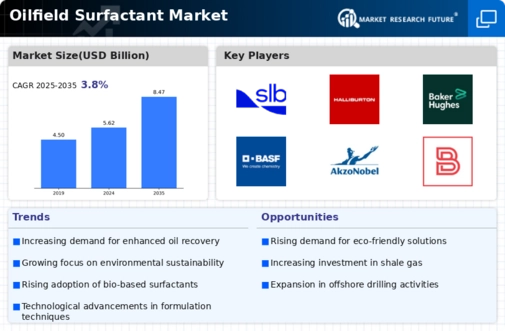Sustainability Initiatives
The Oilfield Surfactant Market is increasingly influenced by sustainability initiatives aimed at reducing environmental impact. Companies are adopting eco-friendly surfactants that minimize toxicity and enhance biodegradability. This shift is driven by regulatory pressures and consumer demand for greener products. As a result, the market is witnessing a rise in the development of bio-based surfactants, which are derived from renewable resources. The adoption of these sustainable practices not only aligns with environmental goals but also opens new avenues for market growth. In 2025, the market for bio-based surfactants is projected to reach a substantial share, indicating a significant trend towards sustainability in the oilfield sector.
Technological Advancements
Technological advancements play a pivotal role in shaping the Oilfield Surfactant Market. Innovations in formulation and application techniques are enhancing the efficiency of surfactants in oil recovery processes. For instance, the development of nanotechnology-based surfactants is improving the performance of enhanced oil recovery (EOR) methods. These advancements are expected to increase the overall yield from oilfields, thereby driving demand for specialized surfactants. Furthermore, the integration of digital technologies in oilfield operations is facilitating better monitoring and optimization of surfactant usage. As a result, the market is likely to experience a surge in demand for technologically advanced surfactants, which could lead to a more competitive landscape.
Increasing Exploration Activities
Increasing exploration activities in untapped oil reserves are driving the Oilfield Surfactant Market. As companies seek to discover new oil fields, the need for effective surfactants to facilitate drilling and production processes becomes paramount. Surfactants are essential in reducing friction and enhancing the flow of drilling fluids, which is critical in challenging geological formations. The surge in exploration, particularly in offshore and unconventional resources, is expected to propel the demand for surfactants. In 2025, the market is likely to witness a notable increase in surfactant consumption, reflecting the growing emphasis on exploration and production efficiency.
Rising Demand for Enhanced Oil Recovery
The rising demand for enhanced oil recovery (EOR) techniques is a significant driver for the Oilfield Surfactant Market. As conventional oil reserves deplete, operators are increasingly turning to EOR methods to maximize extraction from existing fields. Surfactants play a crucial role in EOR by reducing interfacial tension and improving oil displacement efficiency. The market for surfactants used in EOR is projected to grow substantially, with estimates suggesting a compound annual growth rate of over 5% through 2025. This trend indicates a robust demand for specialized surfactants tailored for EOR applications, thereby bolstering the overall market.
Regulatory Compliance and Safety Standards
Regulatory compliance and safety standards are increasingly influencing the Oilfield Surfactant Market. Governments and regulatory bodies are imposing stringent guidelines on the use of chemicals in oilfield operations to ensure environmental protection and worker safety. This has led to a shift towards the adoption of safer, less toxic surfactants that meet regulatory requirements. Companies are investing in research and development to formulate surfactants that comply with these standards while maintaining performance efficiency. The market is expected to see a rise in demand for compliant surfactants, as adherence to regulations becomes a critical factor for operational success in the oilfield sector.

















Leave a Comment